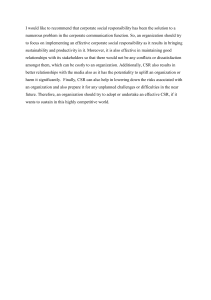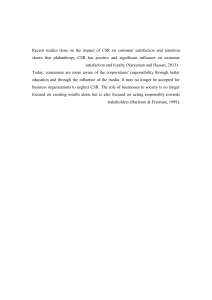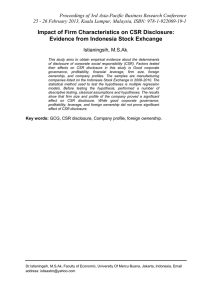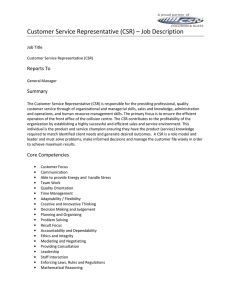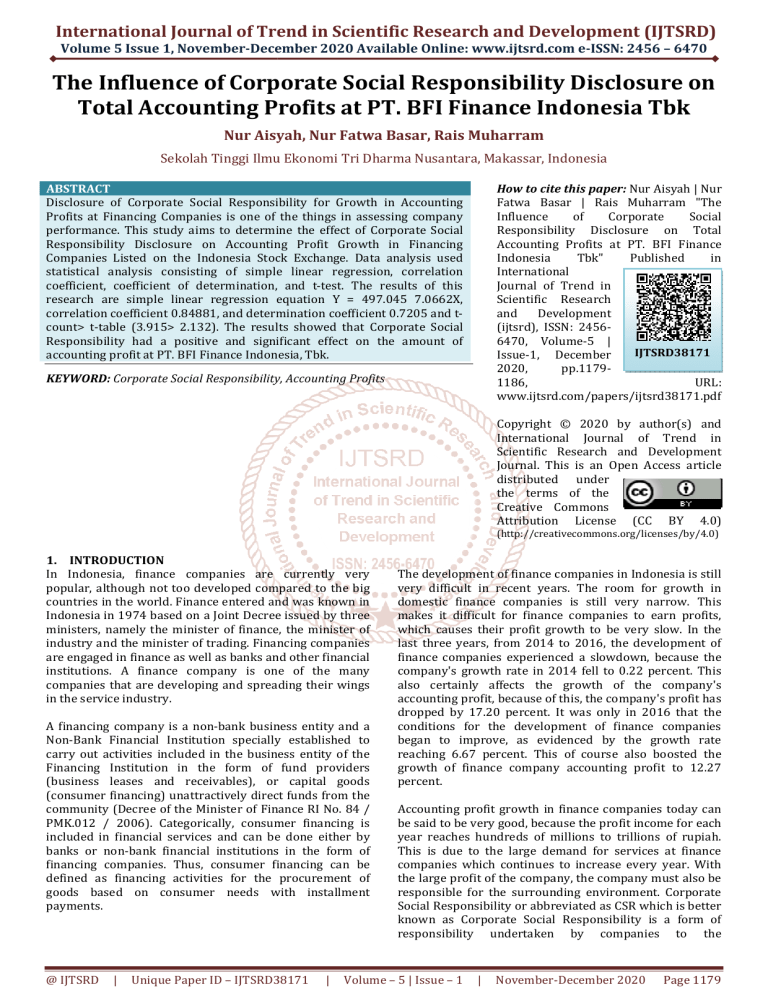
International Journal of Trend in Scientific Research and Development (IJTSRD)
Volume 5 Issue 1, November-December
December 2020 Available Online: www.ijtsrd.com e-ISSN: 2456 – 6470
The Influence off Corporate Social Responsibility Disclosure on
Total Accounting Profits att PT. BFI Finance Indonesia Tbk
Nur Aisyah, Nur Fatwa Basar, Rais Muharram
Sekolah Tinggi Ilmu Ekonomi Tri Dharma Nusantara, Makassar, Indonesia
How to cite this paper: Nur Aisyah | Nur
Fatwa Basar | Rais Muharram "The
Influence
of
Corporate
Social
Responsibility Disclosure on Total
Accounting
ccounting Profits at PT. BFI Finance
Indonesia
Tbk"
Published
in
International
Journal of Trend in
Scientific Research
and
Development
(ijtsrd), ISSN: 24562456
6470, Volume-5
Volume
|
IJTSRD38171
Issue-1,
1, December
2020,
pp.1179
pp.11791186,
URL:
www.ijtsrd.com/papers/ijtsrd3817
www.ijtsrd.com/papers/ijtsrd38171.pdf
ABSTRACT
Disclosure of Corporate Social Responsibility for Growth in Accounting
Profits at Financing Companies is one of the things in assessing company
performance. This study aims to determine the effect of Corporate Social
Responsibility Disclosure on Accounting Profit Growth in Financing
Companies Listed on the Indonesia Stock Exchange. Data analysis used
statistical analysis consisting of simple linear regression, correlation
coefficient, coefficient of determination, and t-test.
t
The results of this
research aree simple linear regression equation Y = 497.045 7.0662X,
correlation coefficient 0.84881, and determination coefficient 0.7205 and tt
count> t-table
table (3.915> 2.132). The results showed that Corporate Social
Responsibility had a positive and significant effect
effec on the amount of
accounting profit at PT. BFI Finance Indonesia, Tbk.
KEYWORD: Corporate Social Responsibility, Accounting Profits
Copyright © 2020
20
by author(s) and
International Journal of Trend in
Scientific Research and Development
Journal. This is an Open Access article
distributed under
the terms of the
Creative Commons
Attribution License (CC BY 4.0)
(http://creativecommons.org/licenses/by/4.0
http://creativecommons.org/licenses/by/4.0)
1. INTRODUCTION
In Indonesia, finance companies are currently very
popular, although not too developed compared to the big
countries in the world. Finance entered and was known in
Indonesia in 1974 based on a Joint Decree issued by three
ministers, namely the minister of finance, the minister of
industry and the minister of trading. Financing companies
are engaged in finance as well as banks and other financial
institutions. A finance company is one of the many
companies that are developing and spreading their wings
in the service industry.
A financing company is a non-bank
bank business entity and a
Non-Bank
Bank Financial Institution specially established to
carry out activities included in the business
busin
entity of the
Financing Institution in the form of fund providers
(business leases and receivables), or capital goods
(consumer financing) unattractively direct funds from the
community (Decree of the Minister of Finance RI No. 84 /
PMK.012 / 2006). Categorically,
tegorically, consumer financing is
included in financial services and can be done either by
banks or non-bank
bank financial institutions in the form of
financing companies. Thus, consumer financing can be
defined as financing activities for the procurement of
goods based on consumer needs with installment
payments.
@ IJTSRD
|
Unique Paper ID – IJTSRD38171
38171
|
The development of finance companies in Indonesia is still
very difficult in recent years. The room for growth in
domestic finance companies is still very narrow. This
makes it difficult for finance
ce companies to earn profits,
which causes their profit growth to be very slow. In the
last three years, from 2014 to 2016, the development of
finance companies experienced a slowdown, because the
company's growth rate in 2014 fell to 0.22 percent. This
also
so certainly affects the growth of the company's
accounting profit, because of this, the company's profit has
dropped by 17.20 percent. It was only in 2016 that the
conditions for the development of finance companies
began to improve, as evidenced by the growth
g
rate
reaching 6.67 percent. This of course also boosted the
growth of finance company accounting profit to 12.27
percent.
Accounting profit growth in finance companies today can
be said to be very good, because the profit income for each
year reachess hundreds of millions to trillions of rupiah.
This is due to the large demand for services at finance
companies which continues to increase every year. With
the large profit of the company, the company must also be
responsible for the surrounding environment.
environm
Corporate
Social Responsibility or abbreviated as CSR which is better
known as Corporate Social Responsibility is a form of
responsibility undertaken by companies to the
Volume – 5 | Issue – 1
|
November--December 2020
Page 1179
International Journal of Trend in Scientific Research and Development (IJTSRD) @ www.ijtsrd.com eISSN: 2456-6470
surrounding environment. Corporate social responsibility
can be in the form of financial assistance or infrastructure.
At first, Corporate Social Responsibility was voluntary, but
over time the nature of CSR has also changed into
something that is required or mandatory. This is regulated
in Law Number 40 of 2007 concerning Limited Liability
Companies (PT Law), which was passed on July 20, 2007.
Article 74 of the Limited Liability Company Law states: (1)
Companies that carry out their business activities in the
field of and / or are related to natural resources are
required to carry out Social and Environmental
Responsibility (TJSL). (2) TJSL is the obligation of the
Company which is budgeted and calculated as the cost of
the Company, the implementation of which is carried out
with due regard to appropriateness and fairness. (3)
Companies that do not carry out their obligations are
subject to sanctions in accordance with the provisions of
laws and regulations. This is what makes all companies
have to carry out their social responsibility towards their
environment.
(Sayekti and Wondabio, 2007) with the research title "The
Effect of CSR Disclosure on the Earning Response
Coefficient" states that CSR has a negative effect on the
Earning Response Coefficient. This is because the results
of the interaction between Unexpected Earnings (UE) and
the control variable beta show negative results for ERC,
this means that the more risky a company is, the lower the
ERC. This is reinforced by an indication that investors
appreciate the CSR disclosed in the company's annual
report.
Research (Kusumadilaga 2010) entitled "The Effect of
Corporate Social Responsibility on firm value with
profitability as a moderating variable" states that CSR
disclosure has a significant effect on firm value. However,
profitability as a moderating variable does not affect the
relationship between CSR disclosure and firm value. Thus,
the size of the profitability obtained by the company will
not affect the company's value for disclosure of Corporate
Social Responsibility. This is also influenced by the
enactment of Law No. 40 of 2007 concerning Limited
Liability Companies.
Meanwhile, Rosiana, Juliarsa, and Ratnasari in their
research in 2013 entitled "The Influence of CSR on Firm
Value with Profitability as a Moderating Variable" stated
that in their testing and analysis results showed that CSR
disclosure had a positive and significant effect on firm
value and profitability was able to strengthen corporate
disclosure. Social Responsibility for company value. The
higher the profitability will make the management able to
carry out and disclose CSR activities more widely and
better in their implementation. Therefore, with various
research results, it is necessary to conduct research
related to the effect of Corporate Social Responsibility
Disclosure on the amount of accounting profit, especially
at PT. BFI Finance Indonesia Tbk.
2. LITERATURE REVIEW
2.1. Accounting Profit
Income statement is a report that measures the success of
operations and company performance for a certain period
of time. The calculation of profit and loss is very important
because it provides both investors and creditors with
@ IJTSRD
|
Unique Paper ID – IJTSRD38171
|
information that can help the company to predict the
amount, timing, and uncertainty of future cash flows. An
accurate forecast of future cash flows determines the
profitability of its claim repayments against the company.
The profit and loss calculation helps financial statement
users predict future cash flows (Irianti, 2008: 5).
The goal of every company is to maximize profits. Profit or
profit (profit) is the difference from income over costs
within a certain period (period). Profit is often used as a
basis for tax imposition, dividend policy, investment
guidelines and decision making and predictive elements
(Harnanto, 2003 in Adiwiratama, 2012: 8).
Profit is the amount of income earned in one period.
According to Prastowo (1995) in Adiwiratama (2012: 8)
accounting profit is the increase in wealth of a business
entity in a certain period, namely the amount that can be
paid to shareholders at the end of the period without
reducing the wealth owned by the business entity at the
beginning of the period. Accounting profit is defined as the
difference between realized revenue from transactions
that occurred during the period and costs related to that
income. Earnings information is often reported in the
issuance of financial statements and is widely used by
shareholders and potential investors in evaluating the
company's capabilities. Profit is used to measure the
efficiency of a company in the use of the company's
economic resources.
Efficiency measures are generally carried out by
comparing current period earnings with previous period
earnings or with other companies in the same industry.
Until now, many have viewed the accounting income
statement as the best information in assessing the
prospects for future cash flows. Therefore, the quality of
accounting earnings reported by management becomes
the center of attention of the company's external parties.
Quality accounting profit is accounting profit that has little
or no distraction and can reflect the company's actual
financial performance. So that the greater the perceptual
disturbance contained in accounting earnings, the lower
the quality of accounting earnings (Yocelyn and
Christiawan, 2012: 83).
In accounting profit, there are various components,
namely a combination of several main components such as
gross profit, operating profit, profit before tax and profit
after tax (Muqodim, 2005: in Adiwiratama, 2012: 8). So
that in determining the amount of accounting profit,
investors can see from the calculation of profit after tax.
Accounting profit has several advantages and
disadvantages. The advantage of accounting profit is that it
is still useful to help make economic decisions, it can be
verified because it is based on actual transactions or facts
supported by objective evidence. Accounting profit meets
the criteria of conservatism, which means that it does not
recognize changes in value but only recognizes realized
profits. However, the weakness of accounting profit is that
it fails to recognize unrealized increases in asset value in
one period due to the principle of historical cost and the
principle of realized conservatism. Where accounting
profit only recognizes profits that are realized (Ferry and
Wati, 2004 in Adiwiratama, 2012: 8).
Volume – 5 | Issue – 1
|
November-December 2020
Page 1180
International Journal of Trend in Scientific Research and Development (IJTSRD) @ www.ijtsrd.com eISSN: 2456-6470
2.2. Corporate Social Responsibility
The current survival of the company depends on the
company's relationship with the community and the
environment in which the company operates and it has
been recognized by the company so that every company
always improves its relationship with its environment.
This is in line with the legitimacy theory which states that
companies have contracts with the public to carry out
their activities based on the values of justice, and how
companies respond to various interest groups to
legitimize company actions. If there is an inconsistency
between the company value system and the community
value system, the company will lose its legitimacy, which
in turn will threaten the company's survival (Haniffa et.
Al., 2005 in Sayekti and Wondabio, 2007: 4).
Corporate social responsibility is a mechanism for an
organization to voluntarily integrate environmental and
social concerns into its operations and interactions with
stakeholders, which goes beyond the organization's
responsibility in the legal field (Anggraini, 2006 in
Kusumadilaga, 2010: 13).
The World Business Council for Sustainable Development
(WBCSD), corporate social responsibility is defined as a
business commitment to contribute to sustainable
economic development, through collaboration with
employees and their representatives, their families, local
communities and the general public to improve the quality
of life in a way which is beneficial both for your own
business and for development (Kusumadilaga, 2010: 1314).
CSR is an idea that makes a company not only responsible
in terms of finances, but also for social and environmental
problems around the company so that the company can
grow sustainably, as Sari (2012) argues in Rosiana, et al.
(2013: 724) which states that the responsibility of the
company extends even further to the community. The
development of CSR is related to the increasing number of
environmental problems that occur due to company
operational activities. In line with this, companies whose
activities are related to natural resources are required to
disclose their CSR, this is stated in Law no. 40 of 2007
concerning Limited Liability Companies (Utama, 2007 in
Rosiana, et al. 2013: 724). Gossling and Voucht (2007) in
Rosiana, et al. (2013: 725) states that CSR can be seen as
an obligation of the business world to be accountable to all
stakeholders, not just one stakeholder. If the company
does not provide accountability to all stakeholders
including employees, customers, communities, local /
global environment, in the end the company will be
considered badly and will not get support from the
community (Rosiana, et al. 2013: 725).
CSR is a form of corporate responsibility to improve social
and environmental problems that occur as a result of the
company's operational activities, therefore CSR plays a
very important role in increasing company value.
According to Heinkel et. al. (2001) in Rosiana, et al. (2013:
725) companies must consider CSR as a profitable longterm strategy, not as a detrimental activity. In addition,
Chariri (2008) in Rosiana, et al. (2013: 725) argue that
CSR disclosure can be used as a managerial tool to avoid
social and environmental problems. Disclosure of CSR
@ IJTSRD
|
Unique Paper ID – IJTSRD38171
|
information in annual reports is one way for companies to
build, maintain, and legitimize the company's contribution
from an economic and political perspective (Guthrie and
Parker, 1990 in Sayekti and Wondabio, 2007: 4).
Disclosure of CSR information itself is endogeneous (Core,
2001; Healy and Palepu, 2001, in Sayekti and Wondabio,
2013: 5). The theoretical foundations that explain this are
stakeholder theory, legitimacy theory, signal theory, and
triple bottom line theory.
2.3.
The Theory of The Relationship Between
Corporate Social Responsibility And The
Amount of Accounting Profit
Corporate Social Responsibility (CSR) is a commitment
and corporate social responsibility to provide support for
community development. CSR is a company's commitment
to managing its business in order to produce positive
results for society. Companies must be well aware of the
role of the community as a stakeholder in their company.
The community has an important role in influencing the
company's existence. Speaking of profit and loss, CSR does
not only benefit the community but also indirectly benefits
the company. The company helps the community develop
and the community supports the development of the
company. With the existence of CSR, the company is
equally growing (Maheka, 2012: 137-138).
The benefits of Corporate Social Responsibility (CSR) for
companies in general in carrying out their social
responsibilities or csr, companies can implement through
three things, namely profit, society (people), and the
environment (planet) (Simanjuntak, 2017: 96). Companies
can pay attention to society by making policies that can
improve welfare, quality of life, community competence
and environmental conservation efforts. The company's
involvement in environmental preservation means that
the company participates in minimizing the impact of
disasters caused by environmental damage. Simanjuntak
(2017: 96) said that CSR can provide many benefits.
The substance of the existence of CSR is the sustainability
of the company in an area, by building cooperation
between stakeholders through community development
programs. Able to improve the company's reputation
which can be viewed as social marketing for the company
and is part of the development of the company's image
(corporate image building). Furthermore, Simanjuntak
(2017: 97) states that the implementation of the
company's CSR will certainly have an impact on the
company's production volume. Products that are absorbed
in the market in the end bring profit / profit to the
company.
3. METHODOLOGY
This study uses quantitative data and secondary data
sources. The population in this study were PT. BFI Finance
Indonesia, Tbk. Data analysis used statistical analysis
consisting of simple linear regression, correlation
coefficient, coefficient of determination, and t-test.
4. RESULTS AND DISCUSSION
Corporate Social Responsibility (CSR) report. Reports on
corporate social responsibility or corporate social
responsibility at PT. BFI Finance Indonesia Tbk. during the
period 2012 to 2017 are presented as follows:
Volume – 5 | Issue – 1
|
November-December 2020
Page 1181
International Journal of Trend in Scientific Research and Development (IJTSRD) @ www.ijtsrd.com eISSN: 2456-6470
Table 1: BFI Finance’s CSR Report
Tahun
Dana CSR
2012
1.313.650.000
2013
831.550.998
2014
1.110.918.310
PT. BFI Finance Indonesia, Tbk. (BFIN)
2015
47.118.594.462
2016
54.811.699.637
2017
62.925.404.730
Total
168.111.818.137
In 2012, PT. BFI Finance Indonesia spent IDR1.313.650.000 for its corporate social responsibility budget and this budget
was fully used for several fields, including education, health, infrastructure, joint programs with csr units and promotion
units, and for donations. general. Then in 2013, the company did not use the full CSR budget, the company only used
IDR831.550.998 of the total funds that had been budgeted which were used for social, education, environmental, charity
and disaster relief activities, health, as well as the infrastructure sector. In 2014, the company again used all of its csr
budget funds in full amounting to IDR1.110.918.310 for activities in the fields of education, health, infrastructure, the
environment, as well as for charity and general donations. In 2015, funds spent on csr activities amounted to
IDR47.118.594.462 for activities in the environment, labor practice, occupational health and safety, social and community
development, and responsibility towards consumers. Then in 2016, the company spent IDR54.811.699.637 for CSR
activities in the same field as the previous years. In 2017, the company budgeted IDR62.925.404.730 for CSR activities in
the fields of environment, labor practices, health and safety, social and community development, and responsibility
towards consumers. These activities are carried out in order to strengthen the company's relationship with the
surrounding community. It also aims to increase the company's image or good name in the eyes of the public.
Accounting Profit Report
Accounting profit report at PT. BFI Finance Indonesia Tbk. during the period 2012 to 2017 are presented as follows:
Table 2: Accounting Profit Report BFI Finance
Tahun Laba Perusahaan
2012
490.272.000.000
2013
508.619.000.000
2014
564.682.000.000
PT. BFI Finance Indonesia, Tbk. (BFIN)
2015
712.919.000.000
2016
735.321.000.000
2017
1.158.370.000.000
Total
4.170.183.000.000
PT. BFI Finance Indonesia, Tbk. in 2012 earned an operating profit of IDR 490.272.000.000 on business activities. In line
with the company's business, in 2013 the company earned a profit of IDR 508.619.000.000 which increased from the
previous year. Then in 2014, the company again earned a profit of IDR 564.682.000.000 which continued to increase from
previous years. In 2015, the company earned a profit of IDR 712.919.000.000. Then in 2016, the company's profit
continued to increase until it reached a value of IDR 735.321.000.000. Then in 2017, the company earned a profit of IDR
1.158.370.000.000.
Static Analysis
To determine the effect of corporate social responsibility (CSR) on the amount of company accounting profit, analysis
methods are used, namely simple linear regression equations, correlation coefficients, coefficient of determination and t
test.
Simple Linear Regression
To get the results of simple linear regression equations, it is necessary to determine the components of simple linear
regression calculations. To get the constant coefficient values of a and b values, the results of the above calculations are
used to obtain a simple linear regression equation.
A. Calculating the constant value b is used the following formula:
∑
b=
∑
∑
∑
∑
B. Calculating the value of the constant a is used the following formula:
−
∑
@ IJTSRD
|
a=
∑
Unique Paper ID – IJTSRD38171
|
Volume – 5 | Issue – 1
|
November-December 2020
Page 1182
International Journal of Trend in Scientific Research and Development (IJTSRD) @ www.ijtsrd.com eISSN: 2456-6470
Kode
BFIN
Total
Table 4 Simple Regression Calculations (in Millions)
X
Y
XY
X2
Y2
1.314
490.272
644.217.408
1.726.596
240.366.633.984
832
508.619
423.171.008
692.224
258.693.287.161
1.111
564.682
627.361.702
1.234.321
318.865.761.124
47.119
712.919
33.592.030.361 2.220.200.161 508.253.500.561
54.811
735.321
40.303.679.331 3.004.245.721 540.696.973.041
62.925 1.158.370 72.890.432.250 3.959.555.625 1.341.821.056.900
168.112 4.170.183 148.480.892.060 9.187.654.648 3.208.697.212.771
A. Calculate the constant value b
6 148.480.892.060 − 168.112 4.170.183
b=
6 9.187.654.648 − 168.112
b=
b=
890.885.352.360 − 701.057.804.496
55.125.927.888 − 28.261.644.544
189.827.547.864
26.864.283.344
b = 7,0662
B. Calculate the constant value a
4.170.183 7,0662 168.112
a=
−
6
6
a = 695.030,5 − 197.985,5
a = 497.045
Then a simple linear regression equation is obtained:
Y = 497.045 + 7,0662X
From the simple linear equation above, it can be seen that the significant influence between corporate social responsibility
(X) on the amount of accounting profit (Y), at PT. BFI Finance Indonesia, Tbk. namely: The constant value of alpha (a) is
497.045. That is, if the value of corporate social responsibility (X) is equal to zero (no change) then the growth in
accounting profit (Y) at PT. BFI Finance Indonesia, Tbk. amounting to 497.045.
The value of the beta regression coefficient (b) is 7.0662. That is, if corporate social responsibility (X) increases by 1, then
the amount of accounting profit (Y) at PT. BFI Finance Indonesia, Tbk. will increase by 7.0662.
Correlation coefficient
The correlation coefficient is a statistical test to find the relationship / linkage of variables. To be able to determine the
relationship between corporate social responsibility (X) and the company's accounting profit (Y), the correlation
coefficient equation is used, as follows:
! ∑X
r=
r=
r=
r=
r=
n ∑ XY − ∑ X ∑ Y
− ∑X " ! ∑ Y
− ∑Y "
6 148.480.892.060 − 168.112 4.170.183
6 9.187.654.648 − 168.112 " 6 3.208.697.212.771 − 4.170.183 "
890.885.352.360 − 701.057.804.496
55.125.927.888−28.261.644.544 " 19.252.183.276.626 − 17.390.426.253.489 "
189.827.547.864
26.864.283.344 1.861.757.023.137
189.827.547.864
√50.014.768.187.234.300.000.000
189.827.547.864
223.639.817.982
r = 0,84881
@ IJTSRD
|
Unique Paper ID – IJTSRD38171
|
Volume – 5 | Issue – 1
|
November-December 2020
Page 1183
International Journal of Trend in Scientific Research and Development (IJTSRD) @ www.ijtsrd.com eISSN: 2456-6470
From the calculation of the correlation coefficient (r) is 0.84881, so the level of relationship between disclosure of
corporate social responsibility (csr) to the amount of accounting profit at PT. BFI Finance Indonesia Tbk. is very strong.
That is, the disclosure of corporate social responsibility on the amount of company accounting profit has a positive effect
so that there is a unidirectional relationship between variables (X) and (Y).
The coefficient of determination (r2)
The coefficient of determination is used to determine how much variable (X) corporate social responsibility affects the
variable (Y) accounting profit. Then the coefficient of determination is calculated using a formula, namely:
Kd = (r2)
Kd = (0, 84881)2
Kd = 0, 7205
Kd = 72, 05%
So the coefficient of determination r2 obtained is 0.7205, this means that the effect of disclosure of corporate social
responsibility (CSR) on the total company accounting profit is 72.05%. While the remaining 27.95% is influenced by other
variables not included in the study.
t-test
The t-test or hypothesis testing is used to test the hypothesis about the effect of disclosure of corporate social responsibility
on the amount of company accounting profit at PT. BFI Finance Indonesia, Tbk. can be accepted or rejected, with the
following steps:
A. t-table
To be able to determine the t-table value, the first thing that needs to be done is to determine the degree of freedom (DF)
value first. This t-table test uses a one-way test for a significant level of 5 percent or 0.05, then the formula that will be used
to determine the degree of freedom (df) is as follows:
df = n - 2
df = 6 - 2
df = 4
t-tabel = 2,132
B. t-count
The next hypothesis test is to determine the t-count value, then the following formula is used:
r
t=
&1 − r
n−2
t=
t=
t=
t=
t=
t
0,84881
&1 − 0,84881
6−2
0,84881
&1 − 0,7205
4
0,84881
&0,2795
6
0,84881
√0,047
0,84881
0,2168
'() *
= 3,915
From the calculation of the df value of 6 with a significant level of 5 percent or 0.05, the value of the one-way statistical ttable hypothesis test is 2.132. Therefore, t-count> t-table (3,915> 2,132) at the 5 percent or 0.05 level so that it is stated
that disclosure (csr) has a positive and significant effect on the company's accounting profit, so H0 is rejected and Ha is
accepted. Then the area of acceptance for Ha and rejection of H0 can be seen in the following figure:
@ IJTSRD
|
Unique Paper ID – IJTSRD38171
|
Volume – 5 | Issue – 1
|
November-December 2020
Page 1184
International Journal of Trend in Scientific Research and Development (IJTSRD) @ www.ijtsrd.com eISSN: 2456-6470
Figure 1: Graph of acceptance area Ha
From the graph of regional acceptance Ha, it shows that there is sufficient evidence to reject H0. So it can be concluded that
the hypothesis previously proposed by the researcher can be accepted.
The results show that disclosure (CSR) has a positive and significant effect on the growth in accounting profit of PT. BFI
Finance Indonesia Tbk. So this is in accordance and supports the research conducted by Rimba Kusumadilaga in 2010
which states that CSR will increase firm value when profitability is high. This means that if the CSR is higher, it will
continue to increase the value of the company and will
wi also affect the company's profits.
In the triple bottom line theory, the implementation of sustainable development can be applied to a business / business
through the Triple-P
P or triple bottom line concept by combining three aspects of conducting the business,
b
which include:
Profit, People and Planet. So that the results of this research are in accordance with the triple bottom line theory put
forward by John Elkington, (1995) because the company has distributed dividends to its shareholders. The company
compan has
also provided social and community assistance to victims of natural disasters and provided assistance to orphanages and
other parties in need. As well as the company has carried out its responsibility towards the surrounding environment by
planting mangroves
angroves and cleaning coastal areas in several areas.
Table 3: Results of Simple Linear Regression Analysis
No
Statistic Analysis
Result
1 Simple Linear Regression Y= 497.045+7,00662X
2
Correlationcoefficient
0,84881
3 Coefficient determination
0,7205 atau 72,05%
4
t-count
3,915
5
t-table
2,132
The overall research results can be seen from the table above, where the results of the simple regression statistical test are
ar
Y = 497.045 7.0662X, the results of the statistical test for the correlation coefficient are 0.84881, the results of the
statistical test for the coefficient of determination are 0.7205 or 72.05 percent, the results of t -count is 3,915 and t-table is
2,132. So it can be concluded that the disclosure of corporate social responsibility
responsibility has a positive and significant effect on
the amount of company accounting profit
References
[1] Adiwiratama, Jundan. 2012. “Pengaruh Informasi
Laba, Arus Kas, dan Size Perusahaan Terhadap
Return Saham”. Jurnal Ilmiah Akuntansi dan
Humanika JINAH,, Vol. 2 No. 1. Universitas
Pendidikan Ganesha. Singaraja. Bali.
[2]
Hadad, Muliaman D., dan Istiana Maftuchah. 2015.
“Sustainable Financing: Industri Jasa Keuangan
dalam Pembiayaan Berkelanjutan”.
Berkelanjutan” Elex Media
Komputindo. Jakarta.
[3]
Ibrahim, Chanafi,
anafi, dkk. 2011. Majalah Ilmiah Mawas.
Majalah. Vol. 24 No. 1, hal. 203-204. Universitas
Muria. Kudus. Indonesia.
[4]
Irianti, Tjiptowati Endang. 2008. “Pengaruh
Kandungan Arus Kas, Komponen Arus Kas dan Laba
Akuntansi Terhadap Harga dan Return Saham”.
Ringkasan Tesis.. Universitas Diponegoro. Semarang.
@ IJTSRD
|
Unique Paper ID – IJTSRD38171
38171
|
[5]
Kusumadilaga, Rimba. 2010. “Pengaruh Corporate
Social Responsibility Terhadap Nilai Perusahaan
dengan Profitabilitas sebagai Variabel Moderating”.
Skripsi.. Universitas Diponegoro. Semarang.
[6]
Maheka, Arya. 2012. “Bagaimana
“
Mendirikan &
Mengelola Bisnis Secara Baik & Aman”.
Aman Kanisius.
Cetakan Kelima. Yogyakarta.
[7]
Nambung, 2016. “Pengaruh Motivasi Terhadap
Kinerja Pegawai Pada Unit Pelaksana Tekhnis Dinas
Sanggar Kegiatan Belajar (SKB) Kabupaten
Takalar”. Skripsi tidak dipublikasikan. STIE Tri
Dharma Nusantara. Makassar.
[8]
Praditha, Riza. 2014. “Pengaruh Efisiensi Operasi,
Produktivitas Aktiva dan Pendanaan Utang
Terhadap Rentabilitas Modal Sendiri pada
Perusahaan Pembiayaan Konsumen di Indonesia”.
Tesis. Universitas Muslim Indonesia. Makassar.
Volume – 5 | Issue – 1
|
November--December 2020
Page 1185
International Journal of Trend in Scientific Research and Development (IJTSRD) @ www.ijtsrd.com eISSN: 2456-6470
[9]
Rosiana, Gusti Ayu M.E, dkk. 2013. “Pengaruh
Pengungkapan CSR Terhadap Nilai Perusahaan
dengan Profitabilitas sebagai Variabel Pemoderasi”.
E-Jurnal Akuntansi, Vol. 5 No. 3. Fakultas Ekonomi
dan Bisnis Universitas Udayana. Bali. Indonesia.
[10]
Santoso, Imam 2009. “Akuntansi Keuangan
Menengah (Intermediate Accounting)”. Buku Dua.
Rafika Aditama, Bandung.
[11]
Sayekti, Yosefa, dan Ludovicus Sensi Wondabio.
2007. Simposium Nasional Akuntansi X: “Pengaruh
CSR Disclosure terhadap Earning Response
Coefficient”. Unhas. Makassar.
[12]
Simanjuntak, Bungaran Antonius. 2017. “Konsepku
Mensukseskan Otonomi Daerah: Membangun
Indonesia Berkeadilan Sosial-Ekonomi”. Yayasan
Pustaka Obor Indonesia. Cetakan Pertama. DKI
Jakarta.
@ IJTSRD
|
Unique Paper ID – IJTSRD38171
|
[13]
Susanto, A.B, dan R. Masri Sareb Putra. 2010.”60
Management Gems: Applying Management Wisdom
in Life”. Gramedia Pustaka Utama. Jakarta.
[14]
Sutedi, Adrian. 2015. “Buku Pintar Hukum Perseroan
Terbatas”. Cetakan I. Raih Asa Sukses. Jakarta.
[15]
Suwardjono, 2011. “Akuntansi Pengantar 1 Proses
Penciptaan Data Pendekatan Sistem”. Edisi Ketiga.
BPFE-Yogyakarta. Yogyakarta.
[16]
Yocelyn, Azilia, dan Yulius Jogi Christiawan. 2012.
“Analisis Perubahan Arus Kas dan Laba Akuntansi
Terhadap Return Saham pada Perusahaan
Berkapitalisasi Besar”. Jurnal Akuntansi dan
Keuangan, Vol. 14. No. 2. Fakultas Ekonomi
Universitas Kristen Petra. Surabaya.
Volume – 5 | Issue – 1
|
November-December 2020
Page 1186

